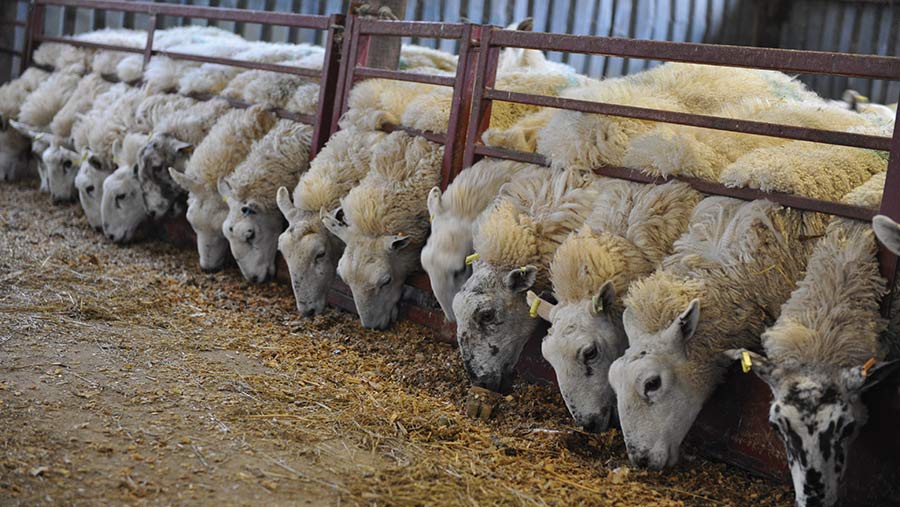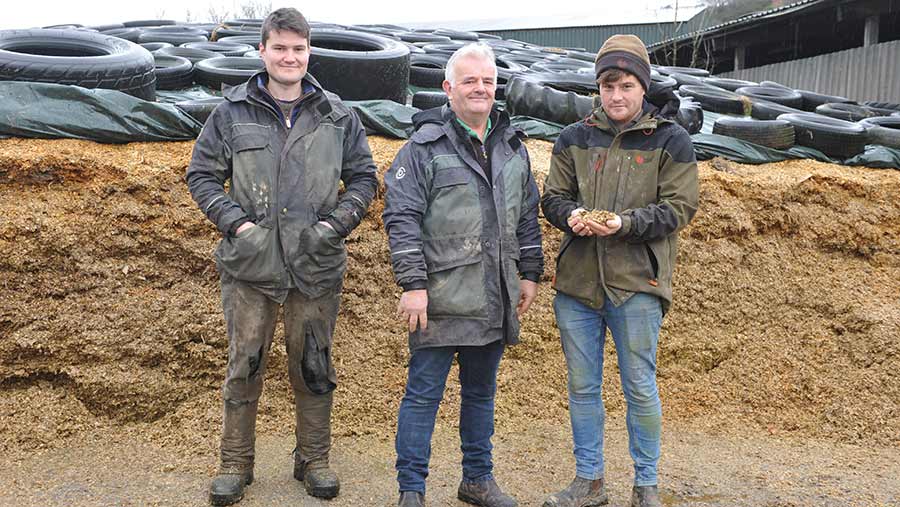How feeding maize silage has cut ration cost by £10 a ewe
 © Debbie James
© Debbie James Switching the winter housing ration from conserved grass to maize silage was an unplanned change at Wern Ddu near Newtown in Montgomeryshire.
Ten years on, and its financial and health benefits make it a permanent feature for the business run by Richard Jones and his sons, Fraser and Oliver.
Initially, maize was clamped as a feed to finish their cattle in combination with cereals.
Unfortunately, the animals did not perform as well as they had hoped on it.
See also: Advice on feeding pregnant ewes when winter fodder stocks low
“The cattle were picking the straw over the maize because they needed the roughage, so we found ourselves with a pit full of maize silage, which we just weren’t going to get through,’’ Richard recalls.
Feeding it instead to the 800 ewes during the lambing period was “experimental’’.
“We realised very quickly that it suited the sheep well, and after feeding it for 10 years, we would see it as a backwards step to return to grass silage,’’ he says.
Farm facts: Wern Ddu near Newtown, Montgomeryshire
- 800 home-bred Mule ewes from Welsh and Beulah genetics
- Flock scanned at 160%
- Lambing from 5 March
- Lambs and cattle sold through live markets
- Lambs sold from mid-June
- Free-range laying flock
- 50-cow suckler herd

Oliver, Richard and Fraser Jones © Debbie James
Health benefits
For the Jones family, maize silage scores highly on cost and, although there is no scientific evidence to back up the health gains that have been achieved since introducing it, they think these are significant.
Previously, when grass silage was used as the forage source, about 10% of the ewes needed antibiotics to treat foot health issues but in the 2023 lambing period no antibiotics were needed for foot-related issues.
“We put it down to maize being a drier feed,’’ says Fraser.
There have been no cases of prolapse in recent years either, he adds.
“There is no science between feeding maize and preventing prolapse, although in the last 10 years, we have gone from having around 40 cases during lambing to not having a single one last year.’’
Establishment costs
The business grows 10ha (24 acres) of maize, drilling seed in the second week of June to harvest in mid-October.
Drilling had been on 1 May but that did not produce earlier harvesting.
“Maize seed hates the cold, and if it does manage to germinate in a cold spring it doesn’t get off to a flying start, so we are not in a rush to get it drilled like we were five years ago,’’ Oliver explains.
The crop was first grown under plastic. After supply chain issues prevented its use one year – with no adverse effect on yield or harvesting date – it stopped being used.
It is harvested with a longer chop length as it is not fed in a complete diet mix, and does not need to be mixed with other feeds.
Maize costs the business £1,111.50/ha to produce, from establishment to clamping, including sheets and harvesting, yielding an average of 49t/ha. This works out at a cost of £4 a ewe each year.
Last year’s analysis was 30.2% dry matter (DM), 7.6% crude protein, 25.8% starch, and a digestibility value of 73.1%.
The metabolisable energy came to 11.5MJ/kg DM with a neutral detergent fibre (NDF) of 38.6%.
“We usually get a higher protein level than this, but the crop didn’t get much sun and we harvested it after exceptionally wet conditions, so this may have had an impact,’’ says Fraser.
Ration at housing
The Mule ewes were housed for lambing in late December 2023 (three weeks earlier than usual because of adverse weather), having grazed fodder beet for four weeks.
Their ration consists of maize silage, hay or straw as roughage, and a protein supplement sprinkled on top. In some years, when maize protein is high, a 16% supplement is fed.
At this protein level, Fraser calculates that each ewe receives an average of 20kg a head of supplement over the season – at 350g a head a day – which equates to £6 a ewe for singles.
“Many similar systems would spend £25-£30 on concentrates over lambing, so that is where we are making the saving by feeding maize silage.’’
However, this lambing season, an 18% or 19% protein concentrate is likely to be fed to balance the low protein in the maize, increasing the cost slightly. In total, maize plus the concentrate is £10 a ewe.
A skidsteer is used to deposit maize in heaps along the shed passageways, and it is then distributed along the feed barrier manually.
“We don’t feed precise quantities because we don’t weigh the maize but, after a day or two, we can work out what they need from what they are eating or leaving behind,’’ says Oliver.
Compared with forking out silage, half an hour has been shaved off the job of feeding out.
“In the peak of lambing, that time saving is really important because it gives us extra time to get other things done. It is also physically easier than feeding grass silage.’’
Growing grass has been a challenge during recent hot summers. In contrast, the maize performs well, and in the last drought, Fraser reckons they would have had to sell stock in November had they not had it.
Challenges
But growing maize is not without its challenges – the principal one being not always having the right conditions for harvesting, he adds.
“We will have to flat-lift the maize ground this spring if we put it back into a three-year grass ley, otherwise it won’t be as productive because of panning. That will be an additional cost for next year’s crop.’’
With a relatively small acreage to harvest, getting it cut in a window of opportunity can be difficult too.
“We are not high on the priority list, and are at the mercy of the contractor,’’ says Fraser.
That aside, maize will remain an important feed in the system for cost and health reasons.
“Everything we do on the farm has to make money. We are not in a position to carry anything,’’ says Richard.
Advice on feeding maize silage to ewes
Maize silage should be balanced with grass silage and appropriate concentrates when fed to pregnant ewes, advises independent sheep consultant Kate Phillips.
“It is easy for ewes to get fat on maize because it can be very potent, especially if fed ad-lib, so monitor ewe condition – it needs to be maintained in late pregnancy,’’ she says.
Feeding a high-protein supplement is important because maize is typically 8-9% protein, compared with grass silage at 10-16%.
With starch levels ranging from 20-40%, there should also be appropriate levels of rumen degradable protein (RDP) in the diet to balance that high level of fermentable energy, says Kate.
“There should be sharp fibre [such as straw] included in the diet.”
Where the protein source is being sprinkled on top of the forage, allow 45cm of feed space a ewe so each gets their fair share.
“If relying on mainly forage, make sure balanced minerals and vitamins are supplied at the recommended rate, either in the concentrates or separately.
“Maize tends to be lower in calcium than grass silage.”
